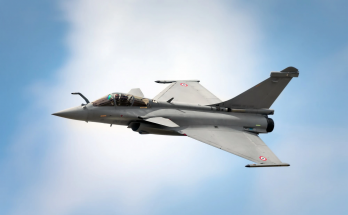by Dan Darling, International Military Markets Analyst, Forecast International.

Type 056 (Jiangdao class) corvette. Source: 樱井千一 – Own work, CC BY-SA 3.0
Marking a new step in military cooperation between China and Malaysia, Malaysia’s Prime Minister Najib Razak has announced that his country will be purchasing “at least” four naval ships from China tailored for missions in littoral waters.
The deal will involve Chinese-designed Littoral Mission Ships (LMS), and up to 10 could potentially be produced. Most likely these new ships are scaled-down derivatives of the People’s Liberation Army Navy (PLAN) Type 056A (Jiangdao class) corvette, similar to the type ordered by the Bangladesh Navy, the Durjoy class. Those ships were built by Wuchang Shipbuilding Industry Company, part of the larger China Shipbuilding Industry Corporation (CSIC). Under the deal, the first two of these new Malaysian Navy ships will be built in China, with the next two built in Malaysia. Any additional ships added via an exercised option would also be built in Malaysia, though these will be subject to government financing resources.
The move by Malaysia to order Chinese naval ships comes as China continues to try to diplomatically move countries in Southeast Asia toward its corner and away from U.S. influence.
Since July, when China’s claims to over 80 percent of the territorial waters in the South China Sea were blocked by an international tribunal at The Hague, Beijing has tried a different tactic, wooing through trade and defense cooperation rather than militarized maritime intimidation and force. Thanks to the election of an impulsive, nationalistic and left-leaning president, the first country to slide over into China’s orbit has been a key one – the Philippines.
The Philippines is important not only because it took China to court over its broad South China Sea claims – its claims to the disputed Scarborough Shoal in particular – but because it has a strategic geographic regional position and long-standing ties with the U.S. With defense cooperation between the U.S. and the Philippines growing closer in the waning years of the Aquino administration and basing rights opening up for American forces, the Philippines presented a crucial plank in Washington’s “strategic pivot” to the Indo-Pacific region. But now firebrand Filipino President Rodrigo Duterte is pushing away from the U.S. and warming to China, with Beijing rewarding Manila by withdrawing warships from the Scarborough Shoal.
Effective Chinese diplomacy has come not only from a military-backed carrot-and-stick approach, but by leveraging its trade heft and pouring investments into developing nations. In Malaysia’s case, a Chinese firm (China Communications Construction Co) was recently awarded an $18.3 billion contract to build a new 385-mile rail link to Kuala Lumpur along the country’s peninsular eastern coast.
Although the two sides have traditionally had fairly warm relations, in recent years worries had grown in Malaysia over China’s competing claims over territory occupied by Malaysia in the Spratly Islands. The encroachment of Chinese fishing and Coast Guard vessels upon Malaysia’s exclusive economic zone has also been a cause for concern.
Nonetheless, while Malaysia monitored the activities of the Chinese Navy in the South China Sea, it was careful to maintain a close relationship with Beijing and cultivate confidence-building gestures in the military domain. Because of this past, any state visits between the two sides would normally fall beneath the radar of Washington, which is far more alarmed by developments in the Philippines.
But what has to be eye-opening for Washington is that Malaysia is not only purchasing Chinese-built hardware, but doing so at a time when the Razak government is slashing the national defense budget for 2017 by 13 percent, therefore bypassing most military modernization efforts in the process. Even more symbolic is that Malaysia is seeking a naval acquisition from the one nation that threatens its own territorial claims. While not prepared to shift away from Washington (despite a U.S. Justice Department probe into the country’s sovereign wealth fund launched in July), Malaysia is clearly willing to make accommodations with China in an attempt to balance its relations with the two competing powers.
Though the ship acquisition may merely be about cost-effectiveness and a symbolic partnership with China and not a strategic realignment, the step is indeed noteworthy. Traditionally Malaysia’s defense procurement emphasis has been on diversification of sources, with Russian combat aircraft, French submarines, British frigates and South Korean armored personnel carriers providing just some of the Malaysian armed forces’ hardware. Thus, once again adding another supplier to its list of military provider nations would appear of little consequence for Malaysia. But this is the most significant order for military hardware from China by Malaysia to date, with the FN-6 (HY-6) man-portable surface-to-air missile system ordered in 2009 the only other Chinese-sourced procurement of any note.
Please feel free to use this content with Forecast International and analyst attributions, along with a link to the article. Contact Ray Peterson at +1 (203) 426-0800 or via email at ray.peterson@forecast1.com for additional analysis.
The Forecast International International Military Markets series examines the military capabilities, equipment requirements, and force structures inventories of 140 countries, with corresponding coverage of the political and economic trends shaping the defense market outlook for individual countries and regions.
For 50 years, Forecast International intelligence reports have been the aerospace and defense industry standard for accurate research, analysis, and projections. Our experienced analysts compile, evaluate, and present accurate data for decision makers. FI's market research reports offer concise analysis of individual programs and identify market opportunities. Each report includes a program overview, detailed statistics, recent developments and a competitive analysis, culminating in production forecasts spanning 10 or 15 years. Let our market intelligence reports be a key part of reducing uncertainties and mastering your specific market and its growth potential. Find out more at www.forecastinternational.com



